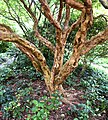| Polyspora axillaris | |
|---|---|
 | |
| Scientific classification | |
| Kingdom: | Plantae |
| Clade: | Tracheophytes |
| Clade: | Angiosperms |
| Clade: | Eudicots |
| Clade: | Asterids |
| Order: | Ericales |
| Family: | Theaceae |
| Genus: | Polyspora |
| Species: | P. axillaris |
| Binomial name | |
| Polyspora axillaris (Roxburgh ex Ker Gawler) | |
| Synonyms | |
List
| |
Polyspora axillaris is a species of evergreen tree or shrub that can grow up to 9 m tall. [1] It has been given the name fried egg plant for its white and yellow flower. [2] P. axillaris is found in southern China, including Hong Kong and Hainan. Is also grows in the wild in Taiwan and Vietnam, and is a garden tree all over the world.
Contents
While earlier grouped under Gordonia , the genus Polyspora has been found to be not closely related to the North American species, thus transferring the species to its own genus. [3]



